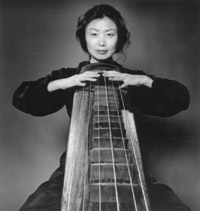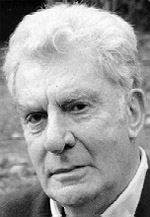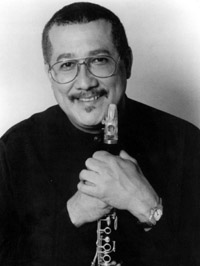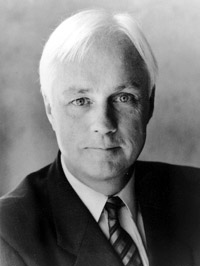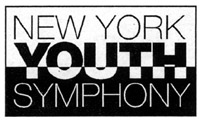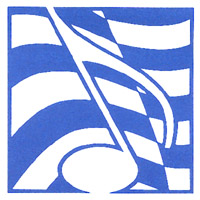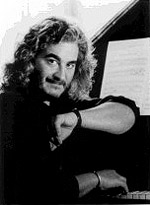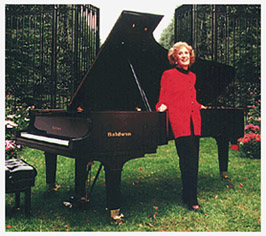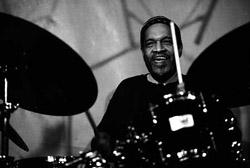 Billy Higgins Photo by Dimitri Ianni |
Billy Higgins, one of the best-loved and most-recorded drummers in postwar jazz, died on May 3, 2001, at Daniel Freeman Hospital in Inglewood, Calif. He had been in failing health and was awaiting his second liver transplant. He was 64 and lived in Los Angeles.
“Billy Higgins was the drummer of the 20th century who put the music back into the drums,” commented bassist Ron Carter. “He was fabulous. He always played the form, and he was aware not only of the soloists, but also of his rhythm section mates.” Higgins was known for his “light but active swing,” his “delicate symbol sound,” and a “melodic style of drumming,” according to New York Times jazz critic Ben Ratliff. Carter remembers that Higgins carefully monitored the pitch of the drums as it related to the pitch of the bass.
It was such attention to detail that helped to make Billy Higgins “the consummate professional,” Carter concluded. “He was always on time, with his equipment ready, and he contributed to the general outlook of the group no matter where [we were] or how many people were involved. He made the music feel good.” He got his nickname, “Smiling Billy,” because he always seemed to be in a state of glee while performing.
“His style is well-documented” on over seven hundred recordings, explained pianist Cedar Walton, “but to see Billy in person at his drums was the ultimate jazz experience.” Among the many jazz greats with whom Higgins recorded are Thelonious Monk, Lee Morgan, Donald Byrd, Hank Mobley; Sonny Rollins, Joe Henderson, Pat Metheny, David Murray, Charles Lloyd, John Scofield, and Mr. Walton himself. Besides playing the drums, he sometimes sang and played guitar.
Mr. Higgins started playing the drums at age 5, and at 14 hooked up with another important young musician, the trumpeter Don Cherry, forming a group called the Jazz Messiahs with saxophonist George Newman. In the mid-fifties, Higgins and Cherry befriended the avant-garde sax player/composer Ornette Coleman. They ended up forming a quartet with Mr. Coleman and bassist Charlie Haden that was devoted to playing Coleman’s music.
Mr. Higgins came to New York with Mr. Coleman for an extended booking at the Five Spot Cafe that began in November 1959. The opening night of that stand, according to Jon Thurber of the Los Angeles Times, was “one of the legendary jazz events of the time. The event crowded the room with every available jazz musician and aficionado.” Once settled in New York, he became more or less the house drummer for Blue Note Records for a fifteen-year period starting in 1964, playing on countless hard-bop recordings.
In the 1970’s he became a regular member of the Cedar Walton Trio, which continued into the late 1990’s. He also found steady work with the Timeless All-Stars, as well as the Hank Jones Trio. By the end of the 70’s Mr. Higgins was releasing his own records, beginning with Soweto, Soldier and Once More.
“Billy Higgins’s talent will never be duplicated – not that any style can be – but his mark on jazz history is indelible,” Mr. Walton wrote in a prepared statement. “Billy Higgins represents four decades of total dedication to his chosen form of American music: jazz.”
Billy was honored with a Grammy Award in 1988 for Best Instrumental Composition, an honor he shared with co-composers Ron Carter, Herbie Hancock and Wayne Shorter for their tune “Call Sheet Blues” from the movie Round Midnight. Billy also appeared in the film, and subsequently worked frequently with the film’s star, the late Dexter Gordon, as a member of the Round Midnight Band.
In addition to his recordings and performances, Higgins was also involved in jazz education activities such as teaching workshops, clinics, and master classes on drums and improvisation. Mr. Higgins was on the faculty of the jazz studies program at the University of California at Los Angeles, and taught at World Stage, a Monday-night program for budding musicians in the Leimert Park section of Los Angeles that he founded with Kamau Daa’oud, a poet.
In March 1996 Mr. Higgins had his first liver transplant and needed another one within 24 hours when it was determined that the first liver was bad. Jazz aficionados were surprised when he began playing again, coming to New York with Mr. Coleman, Mr. Lloyd and Harold Land.
His final performance was at the Los Angeles club Bones and Blues, on Jan. 22, 2001, when his students and his colleagues – including Mr. Lloyd and Mr. Land – played in a benefit to support his fight against liver disease.
He is survived by four sons: Ronald, William Jr., David and Benjamin, all of Los Angeles; two daughters, Ricky and Heidi, both of Los Angeles; a brother, Ronald, of Palmdale CA; a step son, Joseph Walker, a nephew, Billy Thedford, and a fiancée, Glo Harris.


